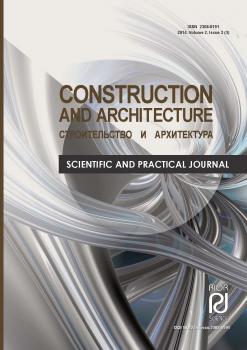Moskva, Moscow, Russian Federation
A priori, both buildings and structures under construction and in operation throughout all life cycles are subjected to various external and internal static, dynamic and other types of impacts. Wind loads play a special role and share of dynamic impacts, the force effect of which, their modules, impact lines and application points are difficult to predict. Nevertheless, such impacts obviously cause kinematic movements with complex trajectories of individual components of buildings and structures, their individual structural elements with different amplitude and frequency. The paper develops an algorithm for finding the kinematic parameters of these structural elements, their speeds and accelerations, which can subsequently be used in digital "BIM" models of buildings. Conceptually, the buildings and structures under consideration were virtually subjected to horizontal high-rise "expansion" during the study by a set of separate material points of the corresponding structural elements in the form of horizontal disks, or separate material points of a set of structural elements performing complex kinematic trajectories as a result of external influences. The algorithm uses definitions given by L. Euler, such as precession angles, nutation angles and angles of proper rotation.
Buildings and structures, kinematic parameters, motion trajectory, angular velocity, angular acceleration, precession angle, nutation angle, angle of proper rotation, digital model
1. Babenko, M. A. Introduction to the theory of algorithms and data structures. / M.A. Babenko, M.V. Levin. - M.: ICNMO, 2014. - 144 p.
2. Vereshchagin, N. K. Lectures on mathematical logic and theory of algorithms. Part 3. Computable functions / N.K. Vereshchagin, A. Shen. - Moscow: SINTEG, 2002. - 192 p.
3. Wirth, N. Algorithms and data structures / N. Wirth - M.: [not specified], 1989. - 760 p.
4. Wirth, N. Algorithms + data structures = programs / N. Wirth. - M.: [not specified], 1992. - 539 p.
5. Gill, A. Introduction to the theory of finite automata / A. Gill. - M.: [not specified], 2005. - 985 p.
6. Alexandrov A.V., Lashchenikov B.Ya., Shaposhnikov N.N. Construction mechanics. Thin-walled spatial systems: Textbook for universities / Edited by A.F. Smirnov. - M.: Stroyizdat, 1983. - 488 p
7. Alexandrov A.V., Potapov V.D. Fundamentals of the theory of elasticity and plasticity. - M.: "Higher School", 2004. - 380 p.
8. Alexandrov A.V., Potapov V. D., Derzhavin B. P. Resistance of materials. - M.: Higher School, 2000. - 560 p.
9. Bate L., Wilson E. Numerical methods of analysis and the finite element method. - M.: Stroyizdat, 1982. - 448 p.
10. Bezdelev V.V., Buklemishev A.V. COMPASS software system. User Manual.- Irkutsk: Publishing house Irkutsk. state Tech. University, 2000 - 120 p., ill.
11. Bezukhov N. I., Luzhin O. V., Kolkunov N. V. Stability and dynamics of structures in examples and problems. M., 1987. -264 p.
12. Bely V. D. Rods and rod systems: textbook. stipend. - Omsk: OmPI, 1979. - 92 p.
13. Bely V.D. Stress and deformations in rods and rod systems: textbook. stipend. - Omsk: OmPI, 1986. - 102 p.
14. Bely V.D. Plates and shells: studies. stipend. - Omsk: OmPI, 1985. - 87 p.
15. Benerdzhi P., Butterfield R. Methods of boundary elements in applied sciences / Translated from English - M.: Mir, 1984. - 494s.


















